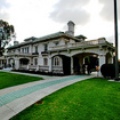
Ziegler Estate (Hornbeck & Wilson, Architects) – 1904
Address: 4601 North Figueroa Street.
(Los Angeles Historic-Cultural Monument No. 416).
The Zeigler Estate located in historic Highland Park combines Queen Anne, Craftsman and Shingle Style into an elegant statement. The mansion has 6 bedrooms and four baths and features an arroyo stone wall. It is situated in the historic core of Highland Park next door to Casa de Adobe.
Full Post

Yoakum House, 1895-1915
Address: 140 S. Avenue 46
(Los Angeles Historic-Cultural Monument No. 287).
Tudor Revival style house built by volunteer labor for Finis Ewing Yoakum, founder of ‘Pisgah House’, a halfway home. Located in the Highland Park neighborhood of Los Angeles.
Full Post

Wrigley Mansion ‘Tournament House” (G. Lawrence Stimson, Architect) – 1906-1914
Address: 391 S. Orange Grove Blvd
Owned by chewing-gum magnate William Wrigley, the Wrigley Mansion was given to the City of Pasadena in 1958, upon Mrs. Wrigley’s death, with the stipulation that it be used as the headquarters for the Pasadena Tournament of Roses Association. The house is magnificently situated at. and includes the Wrigley Gardens, with 4.5 acres of roses representing 1,500 varieties.
Full Post

Wright-Mooers House, 1880
Address: 818 S. Bonnie Brae Street
(Los Angeles Historic-Cultural Monument No. 45).
The Wright-Mooers House is representative of the ‘West Coast Victorian’, an eclectic blend of Queen Anne Victorian with other styles. Note the small pairs of Romanesque columns and the elongated domed roof, perhaps a touch of the Islamic. Located at in the Westlake neighborhood of Los Angeles.
Full Post

Wolf’s Lair (Milton Wolf, Designer) – 1927
Address: 2869 Durand Drive
Historic castle-chateau located at the end of the hiking trail which runs alongside the Castillo del Lago at the foot of Lake Hollywood. Designed by Developer and Art Director Milton Wolf, it has been the residence of both Efrem Zimbalist, Jr. and Doris Day and was featured in the film, ‘Return from Witch Mountain’, starring Bette Davis. The fairy-tale fortress with its crenellated walls, turrets and towers gained a local reputation as being haunted after Wolf died at the dining room table.
Full Post

Woit House (Jno H. Fleming, Architect) – 1934
Address: 3607 Shannon Road
Architect Jno H. Fleming designed the English Tudor Revival style house for Charles S. Woit in 1934. Located in the Los Feliz district of Los Angeles. The architect also designed the Spanish Revival style Lee Holtz Residence on Amesbury Road in 1935.
Full Post

Wirin House (Richard Neutra, Architect) – 1950
Address: 2622 Glendower Avenue
(Los Angeles Historic-Cultural Monument No. 812)
Located directly across the street from the Frank Lloyd Wright-designed Ennis House in Los Feliz, the Wirin House was purchased by celebrity photographer Mark Seliger in 2004. An extensive restoration under the direction of Architect Sharon Johnston-Lee was completed in 2008. Located in the Los Feliz neighborhood of Los Angeles.
Full Post

Received an Order to Comply?
An Order to Comply is a citation issued by the Department of Building and Safety (LADBS) for building code violations or substandard conditions. The Order to Comply may be given to any home or business owner that the LADBS code enforcement division determines is in violation of a building or safety standard found in the Los Angeles Municipal Code.
An Order to Comply may be issued for a number of reasons. A building inspector may literally “drive-by” your property and spot a condition believed to be a violation, or a neighbor may have filed a complaint with the Code Enforcement Division. Finally, during the approval process for new construction it may occur that unapproved construction in the past, even decades old, is found. Once discovered, the current owner is nonetheless liable to fully comply with all Code changes or revisions.
Upon proper notice, inspectors have the legal right to enter your home in order to inspect, note and cite any code violations found with an Order to Comply. You must take effective action within a limited time to resolve the issues identified in an Order to Comply or you may face fines, penalties and fees (and even jail in extreme cases) in addition to the cost of whatever improvements to your property are required.
Building and zoning code violations commonly involve encroachment of “Side-Yard, Front and Rear-Yard Setbacks, Building height restrictions, Change of use, Illegal changes to heating, ventilation or air-conditioning systems, among others. Illegal carport additions are a big “Red Flag” to the Code Enforcement Division because they usually indicate that a garage has been transformed into “Habitable Space”.
In dealing with an Order to Comply, the first step is to obtain a copy of the property’s Certificate of Occupancy (C of O). This document contains the key legal definition of what structures are permitted, inspected and therefore legally allowed to exist on your property. Any deviation from the C of O is a red flag to the Code Enforcement Division.
The compliance process for an Order to Comply can be simple or complex. Verify all the possible legal options you have to legalize your converted or added garage. This will include, but not necessarily be limited to, the building codes, zoning and planning regulations regarding to your property, its legal profile, setbacks, parking, etc.
Chances are, you’re going to need some type of designs and plans drawn, so go out and interview some architects. He or she will work with you on the type of conversion you want, based partially on what you have already constructed, and what may be necessary/allowed on your property.
If and when the initial plans are approved by your City and you get the requisite building permit(s) for the conversion, you’re ready to do or have any further construction work performed. Please note that the city gives you a definite time frame to start the work, otherwise a new approval process and permit may be necessary. In addition, once cited for illegal construction, all Southern California cities pose firm deadlines for completion on the work, before some heavy-duty fines and penalties kick in.
Full Post

Reporting an illegal structure?
Today, Code Enforcement for the single family residence is only present when a neighbor or tenant complaint is made. LADBS cannot possibly know about code enforcement issues unless they are reported by residents. The most common violation from a neighbor or tenant complaint is an unpermitted garage conversion, guest houses or recreational rooms. Neighbors complain because there is less parking on the street, noise disturbances, jealousy or personal distain.
The City of Los Angeles will give 30 days from the date of the Order to fix all cited issues. The Issuing Inspector might extend the correction time if measures have been taken to resolve all violations. Not complying with the Order could mean daily fines, a lien on the property or even jail time
Homeowners violating code may not realize that they are actually devaluing their property. They may unwittingly be making themselves liable to be issued “Orders to Comply” which can paralyze a refinance, compromise their eligibility and coverage for homeowners’ insurance, delay the sale of the property, and make their property less attractive to people looking to buy.
Reporting code violation is something most hate doing, but in the interest of safety, sometimes it has to be done as a civic responsibility and for the good of everyone. We’ve all heard news reports of converted garage residences burning to the ground and taking the lives of whole families – this is an example of why safety codes are important and the result of decades of research and data collection.
The best way to report a code violation is through the channels established by LADBS. This is a protected right that we all have – the right to approach our government agencies which protect and represent us. You have the right to request the services of a government agency, even if the homeowner is ultimately deemed not in violation of any ordinance. Requesting an inspection by LADBS or Planning cannot be characterized as “harassment.”
Before you report a code violation, find out what permits and code compliance orders already exist by getting a Property Activity Report. The report will tell you all the permits outstanding and any code enforcement in place for that property, and the deadlines for compliance. To obtain a Property Activity Report, visit https://www.permitla.org/ipars/The_nonscript_index.cfm
You may find that there is a valid permit for the project you wanted to report , but if there is no existing permit, then you should create a request for LADBS to come and investigate through their LADBS Code Violation form. To Report a Property Violation, visit http://www.permitla.org/csr/csrContact.cfm?CFID=2973114&CFTOKEN=47093111&jsessionid=26302674371280968036480 and fill up a form. You must supply your contact information, which is kept confidential
Full Post

What Homeowners should Know About Garage Conversions and Guest Houses Built Without Permits
In Southern California, it’s hard to go three blocks without seeing cars parked in front of garages converted into living quarters or offices. Many homeowners did not do the work themselves or even know that the unpermitted construction existed until they were cited by their respective Departments of Building & Safety or Public Works. For whatever reason due diligence wasn’t being observed during the escrow process. You are now left carrying the burden of non-compliance derived from years, possibly decades of oversight.
The biggest issue for most homeowners with an unpermitted guest house or garage conversion is the possibility of losing space they consider part of their home. This could simply be an office or playroom, or it could be living facilities for relatives, an Art Studio, Game room, Guest room, Gym, Media room, Multipurpose room, Music studio, etc. Often times the homeowner is renting out the space, and they are faced with loss of income, in addition to the costs to legalize, or demolish the offending unit.
From having extra optimized storage space, to providing an office in the home, to being able to accommodate family members and guests, an additional legal unit can have a significant increase in your property value. In order to try and keep the unpermitted unit, a great deal of “due diligence” must be performed. Certain laws may or may not apply to protect the homeowner in regard to the existing unpermitted construction and use(s). All zoning, parking, setback, height and lot size requirements must be met.
Take a garage conversion for instance; to convert a garage into any habitable space – like a bedroom, kitchen, den, office, etc., it is not legally possible without first looking into your city’s current local building codes, planning and zoning regulations that may apply to the property. A garage structure is not an approved occupied space for people. Once the use of the garage changes to a habitable space it is considered as a new “conditioned space” and is required to comply with specific technical and legal standards that were not previously required. In terms of Building Code regulations, the homeowner must comply with building code standards, such as structural integrity, ingress and egress, fire, electric, plumbing, air circulation, ventilation, insulation, lightning, and seismic compliance, etc. Zoning regulations on the other hand call for maintaining the required side, back, and front-yards (setbacks) from property lines In addition, a garage conversion may only be accepted as long as the homeowner provides on the property an alternative parking space for the car(s) removed from the original garage. Adding a new garage or carport could do this, and usually it requires another type of permit. Finally, in most cases a guest house does not allow for a kitchen, and neither does a garage.
So before doing any significant design and construction work, the homeowner needs to make a thorough analysis and research into his/her city’s current zoning, planning and building code regulations, requirements and restrictions.